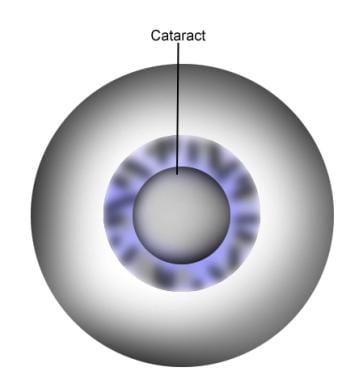Background
Modern extracapsular cataract extraction surgery involves the removal of the lens fibers, which form the nucleus and cortex of the cataract, leaving the posterior epithelial capsule to hold the new artificial intraocular lens (IOL) and keep the vitreous humor away from the anterior chamber. [1] Extracapsular techniques of cataract extraction surgery originally involved manual nuclear expression. Phacoemulsification is a mechanically assisted extracapsular technique of cataract extraction surgery. [1, 2]
A cataract is illustrated in the image below.
Phacoemulsification is illustrated in the image below.
Indications
The patient's desire to improve vision is the most common indication for cataract surgery via phacoemulsification with intraocular lens implantation.
If a patient's best corrected visual acuity does not meet government agencies' and industries' minimum standards of visual function for driving tasks, flying, or operating complex equipment, cataract surgery via phacoemulsification with intraocular lens implantation may need to be considered. [1]
Symptoms of cataract
Symptoms of cataract include the following [1] :
-
Reduced visual acuity (distant and near objects)
-
Daytime glare (sunshine)
-
Nighttime glare (street lights or car headlights)
-
Distortion of lines (wavy, fuzzy)
-
Monocular diplopia
-
Altered colors (white objects appear yellowish, bright colors appear bleached)
-
Not associated with pain, discharge, or redness of the eye
Signs of cataract
Signs of cataract include the following [1] :
-
Reduced visual acuity measured on a Snellen chart or LogMar and near-vision chart
-
An abnormally irregular, dim, or absent red reflex is seen when the retina is viewed with an ophthalmoscope at arm's length. Cortical cataracts cause black-spoke-like shadows coming from the edge of the red reflex. Nuclear and posterior capsular cataracts cause a central black shadow across the red reflex.
-
Reduced contrast sensitivity can be measured by the ophthalmologist using contrast sensitivity charts.
-
Very dense "mature" cataracts causing severely impaired vision present a white pupil.
-
Shallowing of the anterior chamber and angles with very dense cataracts are seen with slit lamp examination
-
After dilating pupils, slit lamp examination shows whether the cataract is cortical, nuclear, or posterior subcapsular, and allows fundus examination.
-
Cataract in children is unusual but may be associated with a white pupil, inability to fix on a target (eg, a light), and the development of a squint.
Technical Considerations
Complication Prevention
Toxic anterior segment syndrome (TASS) is fast becoming a problem for surgeons doing volume surgery in ambulatory surgical centers and hospitals. Its incidence may be avoided with the following:
-
Proper use and maintenance of surgical sterilization units
-
Meticulous care and sterilization of all surgical instruments
-
Avoidance of reusing cannulas
-
Washing out Betadine from the surgical field before beginning surgery
-
Minimizing the excessive use of intracameral injections (antibiotics, vital dyes, viscoelastics)
-
Cataract illustration.
-
Cataract surgery incision, (1.9-2.75 mm), corneal incision, limbal incision, clear corneal, small incision, sutureless.
-
Cataract surgery capsulotomy, capsulorrhexis, continuous tear.
-
Cataract surgery phacoemulsification, phaco, nucleus.
-
Cataract surgery, phacoemulsification, divide and conquer, phaco, chop.
-
Cataract surgery with phacoemulsification cross-section.
-
Cataract surgery illustration of cortex and capsule cleanup using IA.
-
Phacoemulsification with cortex removal. Phaco, aspiration, cataract surgery illustration.
-
Cataract surgery, lens insertion, 3-piece, IOL, intraocular lens implant, shooter, inserter.
-
Intraocular lens implant, IOL, 3 piece lens, in the bag.
-
Cataract surgery illustration with ruptured posterior capsule.
-
Anterior vitrectomy for ruptured posterior capsule during phacoemulsification.
-
Femtosecond laser assisted corneal incisions, capsulotomy, and nucleus fragmentation.
-
(LenSx) Femtosecond Laser Assisted Cataract Surgery (FLACS). Corneal incisions | Capsulotomy | Lens Fragmentation
Tables
What would you like to print?
- Overview
- Periprocedural Care
- Technique
- Exposure and Irrigation
- Paracentesis
- Scleral Tunnel Incisions
- Clear Corneal Incisions
- Continuous Curvilinear Capsulorrhexis
- Hydrodissection and Hydrodelineation
- Nuclear Rotation
- Phacoemulsification
- Nucleus Disassembly
- Irrigation and Aspiration
- IOL Insertion
- Infection and Wound Leak Prevention
- Potential Postoperative Complications
- Show All
- Medication
- Media Gallery
- References



